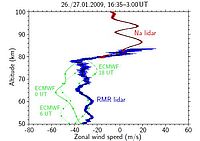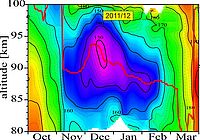Temperature and wind soundings
Precise temperature and wind soundings are crucial for the understanding of the middle atmosphere. The mean temperature and wind structure from the stratosphere up to the lower thermosphere are formed by the large-scale residual circulation, by solar irradiation, and chemical processes. Therefore, observations of winds and temperatures give an insight into the above mentioned processes and from a benchmark test for global circulation models.
Horizontal wind soundings are first possible since a few years with the DoRIS system of the ALOMAR RMR lidar at Andenes (69°N). The ALOMAR RMR DoRIS system is the only lidar in the world capable of measuring winds in the mesosphere. By this, a significant gap in the wind observations by other instruments like radars or satellites has been filled. The ground-based temperature soundings of the different IAP lidars provide at their particular locations important reference data sets for comparison with other data and models. Depending on instrument, regular soundings for many years allow for examination of long-term variation and geophysical trends (e.g., climate change in the mesosphere).
Up to 90 km altitude lidars are able to measure temperatures from the variation of atmospheric density with altitude (RMR lidars at Kühlungsborn and Andenes/ALOMAR). Above, the Doppler-broadening of the backscatter signal is evaluated (e.g. by the mobile Fe lidar, ~80 - 110 km altitude). One campaign of the mobile Fe lidar took place at the Australian station in Antarctica "Davis" (69°S). For the first time, it provided precise observations of the temperature variation in the mesopause region above Antarctica.
All temperature and wind lidars of IAP are daylight-capable. By this a bias in mean temperatures by pure nighttime soundings is avoided. Additionally, daylight-capabilities allow the measurement of tides and long-period gravity waves (inertia gravity waves) or in polar latitudes the summer soundings in general. Technical details of the lidars are described in the Section Instruments.
Selected publications
- R. Wörl, B. Strelnikov, T. P. Viehl, J. Höffner, P.-D. Pautet, M. J. Taylor, Y. Zhao and F.-J. Lübken, Thermal structure of the mesopause region during the WADIS-2 rocket campaign, Atmos. Chem. Phys., 19, 77-88, doi:10.5194/acp-19-77-2019, 2019.
- J. Hildebrand, G. Baumgarten, J. Fiedler and F.-J. Lübken, Winds and temperatures of the Arctic middle atmosphere during January measured by Doppler lidar, Atmos. Chem. Phys., 17(21), 13345-13359, doi:10.5194/acp-17-13345-2017, 2017.
- M. Gerding, M. Kopp, J. Höffner, K. Baumgarten and F.-J. Lübken, Mesospheric temperature soundings with the new, daylight-capable IAP RMR lidar, Atmos. Meas. Tech., 9(8), 3707-3715, doi:10.5194/amt-9-3707-2016, 2016.














